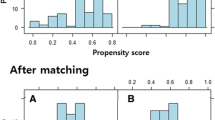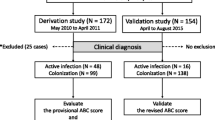Abstract
To develop and validate prediction rules to identify the risk of methicillin-resistant Staphylococcus aureus (MRSA) infection among community patients who have healthcare-associated (HA) exposure and S. aureus bacteremia. A total of 1,166 adults with community-onset S. aureus bacteremia were retrospectively enrolled. The background prevalence of community MRSA infection was extrapolated from 392 community-associated S. aureus bacteremia (CA-SAB) patients without HA exposure. Complete and clinical risk scores were derived and tested using data from 774 healthcare-associated S. aureus bacteremia (HA-SAB) patients. The risk scores were modeled with and without incorporating previous microbiological data as a model predictor and stratified patients to low-, intermediate-, and high-risk groups for MRSA infection. The clinical risk score included five independent predictors and the complete risk score included six independent predictors. The clinical and complete risk scores stratified 32.7 % and 42.0 % of HA-SAB patients to the low-risk group for MRSA infection respectively. The prevalence of MRSA infection in score-stratified low-risk groups ranged from 16.3 % to 23.3 %, comparable to that of CA-SAB patients (13.8 %). Simple decision rules allow physicians to stratify the risk of MRSA infection when treating community patients with prior HA exposure and possible S. aureus infection.



Similar content being viewed by others
References
Jevons MP (1961) “Celbenin”-resistant staphylococci. Br Med J 1:124–125
Diekema DJ, BootsMiller BJ, Vaughn TE, Woolson RF, Yankey JW, Ernst EJ, Flach SD, Ward MM, Franciscus CL, Pfaller MA, Doebbeling BN (2004) Antimicrobial resistance trends and outbreak frequency in United States Hospitals. Clin Infect Dis 38:78–85
Hsueh PR, Teng LJ, Chen WH, Pan HJ, Chen ML, Chang SC, Luh KT, Lin FY (2004) Increasing prevalence of methicillin-resistant Staphylococcus aureus causing nosocomial infections at a university hospital in Taiwan from 1986 to 2001. Antimicrob Agents Chemother 48:1361–1364
Lescure FX, Biendo M, Douadi Y, Schmit JL, Eveillard M (2006) Changing epidemiology of methicillin-resistant Staphylococcus aureus and effects on cross-transmission in a teaching hospital. Eur J Clin Microbiol Infect Dis 25:205–207
Charlebois ED, Perdreau-Remington F, Kreiswirth B, Bangsberg DR, Ciccarone D, Diep BA, Ng VL, Chansky K, Edlin BR, Chambers HF (2004) Origins of community strains of methicillin-resistant Staphylococcus aureus. Clin Infect Dis 39:47–54
Tacconelli E, Venkataraman L, De Girolami PC, Dagata EM (2004) Methicillin-resistant Staphylococcus aureus bacteraemia diagnosed at hospital admission: distinguishing between community-acquired versus healthcare-associated strains. J Antimicrob Chemother 53:474–479
Klevens RM, Morrison MA, Nadle J, Petit S, Gershman K, Ray S, Harrison LH, Lynfield R, Dumyati G, Townes JM, Craig AS, Zell ER, Fosheim GE, McDougal LK, Carey RB, Fridkin SK (2007) Invasive methicillin-resistant Staphylococcus aureus infections in the United States. JAMA 298:1763–1771
Siegman-Igra Y, Fourer B, Orni-Wasserlauf R, Golan Y, Noy A, Schwartz D, Giladi M (2002) Reappraisal of community-acquired bacteremia: a proposal of a new classification for the spectrum of acquisition of bacteremia. Clin Infect Dis 34:1431–1439
Friedman ND, Kaye KS, Stout JE, McGarry SA, Trivette SL, Briggs JP, Lamm W, Clark C, MacFarquhar J, Walton AL, Reller LB, Sexton DJ (2002) Health care-associated bloodstream infections in adults: a reason to change the accepted definition of community-acquired infections. Ann Intern Med 137:791–797
Lubin AS, Snydman DR, Ruthazer R, Bide P, Golan Y (2011) Predicting high vancomycin minimum inhibitory concentration in methicillin-resistant Staphylococcus aureus bloodstream infections. Clin Infect Dis 52:997–1002
Lodise TP, Miller CD, Graves J, Evans A, Graffunder E, Helmecke M, Stellrecht K (2008) Predictors of high vancomycin MIC values among patients with methicillin-resistant Staphylococcus aureus bacteraemia. J Antimicrob Chemother 62:1138–1141
Pillai SK, Wennersten C, Venkataraman L, Eliopoulos GM, Moellering RC, Karchmer AW (2009) Development of reduced vancomycin susceptibility in methicillin-susceptible Staphylococcus aureus. Clin Infect Dis 49:1169–1174
Liao CH, Chen SY, Chang SC, Hsueh PR, Hung CC, Chen YC (2005) Characteristics of community-acquired and health care-associated Staphylococcus aureus bacteremia in patients treated at the emergency department of a teaching hospital. Diagn Microbiol Infect Dis 53:85–92
Wang JL, Wang JT, Chen SY, Hsueh PR, Kung HC, Chen YC, Chang SC (2007) Adult methicillin-resistant Staphylococcus aureus bacteremia in Taiwan: clinical significance of non-multi-resistant antibiogram and Panton-Valentine leukocidin gene. Diagn Microbiol Infect Dis 59:365–371
Laupacis A, Sekar N, Stiell IG (1997) Clinical prediction rules. A review and suggested modifications of methodological standards. JAMA 277:488–494
Shorr AF, Zilberberg MD, Micek ST, Kollef MH (2008) Prediction of infection due to antibiotic-resistant bacteria by select risk factors for health care-associated pneumonia. Arch Intern Med 168:2205–2210
Shorr AF, Zilberberg MD, Reichley R, Kan J, Hoban A, Hoffman J, Micek ST, Kollef MH (2012) Validation of a clinical score for assessing the risk of resistant pathogens in patients with pneumonia presenting to the emergency department. Clin Infect Dis 54:193–198
Moran GJ, Krishnadasan A, Gorwitz RJ, Fosheim GE, McDougal LK, Carey RB, Talan DA (2006) Methicillin-resistant S. aureus infections among patients in the emergency department. N Engl J Med 355:666–674
King MD, Humphrey BJ, Wang YF, Kourbatova EV, Ray SM, Blumberg HM (2006) Emergence of community-acquired methicillin-resistant Staphylococcus aureus USA 300 clone as the predominant cause of skin and soft-tissue infections. Ann Intern Med 144:309–317
Blot SI, Vandewoude KH, Hoste EA, Colardyn FA (2002) Outcome and attributable mortality in critically ill patients with bacteremia involving methicillin-susceptible and methicillin-resistant Staphylococcus aureus. Arch Intern Med 162:2229–2235
Cosgrove SE, Sakoulas G, Perencevich EN, Schwaber MJ, Karchmer AW, Carmeli Y (2003) Comparison of mortality associated with methicillin-resistant and methicillin-susceptible Staphylococcus aureus bacteremia: a meta-analysis. Clin Infect Dis 36:53–59
Salgado CD, Farr BM, Calfee DP (2003) Community-acquired methicillin-resistant Staphylococcus aureus: a meta-analysis of prevalence and risk factors. Clin Infect Dis 36:131–139
Hota B, Lyles R, Rim J, Popovich KJ, Rice T, Aroutcheva A, Weinstein RA (2011) Predictors of clinical virulence in community-onset methicillin-resistant Staphylococcus aureus infections: the importance of USA300 and pneumonia. Clin Infect Dis 53:757–765
Chen SY, Wang JT, Chen TH, Lai MS, Chie WC, Chien KL, Hsueh PR, Wang JL, Chang SC (2010) Impact of traditional hospital strain of methicillin-resistant Staphylococcus aureus (MRSA) and community strain of MRSA on mortality in patients with community-onset S aureus bacteremia. Medicine (Baltimore) 89:285–294
Gonzalez C, Rubio M, Romero-Vivas J, Gonzalez M, Picazo JJ (1999) Bacteremic pneumonia due to Staphylococcus aureus: a comparison of disease caused by methicillin-resistant and methicillin-susceptible organisms. Clin Infect Dis 29:1171–1177
Chang FY, Peacock JE Jr, Musher DM, Triplett P, MacDonald BB, Mylotte JM, O’Donnell A, Wagener MM, Yu VL (2003) Staphylococcus aureus bacteremia: recurrence and the impact of antibiotic treatment in a prospective multicenter study. Medicine (Baltimore) 82:333–339
Stryjewski ME, Szczech LA, Benjamin DK Jr, Inrig JK, Kanafani ZA, Engemann JJ, Chu VH, Joyce MJ, Reller LB, Corey GR, Fowler VG Jr (2007) Use of vancomycin or first-generation cephalosporins for the treatment of hemodialysis-dependent patients with methicillin-susceptible Staphylococcus aureus bacteremia. Clin Infect Dis 44:190–196
Scanvic A, Denic L, Gaillon S, Giry P, Andremont A, Lucet JC (2001) Duration of colonization by methicillin-resistant Staphylococcus aureus after hospital discharge and risk factors for prolonged carriage. Clin Infect Dis 32:1393–1398
Chen SY, Wu GH, Chang SC, Hsueh PR, Chiang WC, Lee CC, Ma MH, Hung CC, Chen YC, Su CP, Tsai KC, Chen TH, Chen SC, Chen WJ (2008) Bacteremia in previously hospitalized patients: prolonged effect from previous hospitalization and risk factors for antimicrobial-resistant bacterial infections. Ann Emerg Med 51:639–646
Miller LG, Perdreau-Remington F, Bayer AS, Diep B, Tan N, Bharadwa K, Tsui J, Perlroth J, Shay A, Tagudar G, Ibebuogu U, Spellberg B (2007) Clinical and epidemiologic characteristics cannot distinguish community-associated methicillin-resistant Staphylococcus aureus infection from methicillin-susceptible S. aureus infection: a prospective investigation. Clin Infect Dis 44:471–482
Acknowledgements
Funding
This study did not receive any outside funding.
Conflicts of interest
All authors declare that they have no conflicts of interest.
Ethical approval
Institutional Review Board, National Taiwan University Hospital, Taipei, Taiwan.
Author information
Authors and Affiliations
Corresponding author
Rights and permissions
About this article
Cite this article
Chen, SY., Chiang, WC., Ma, M.HM. et al. Predicting methicillin resistance among community-onset Staphylococcus aureus bacteremia patients with prior healthcare-associated exposure. Eur J Clin Microbiol Infect Dis 31, 2727–2736 (2012). https://doi.org/10.1007/s10096-012-1621-y
Received:
Accepted:
Published:
Issue Date:
DOI: https://doi.org/10.1007/s10096-012-1621-y




